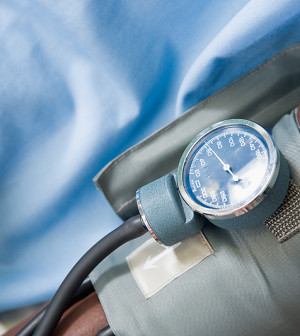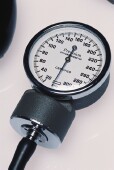- Skip Storing This Everyday Product in the Fridge Door
- Green Tea + B3 Pairing May Boost Brain Health
- Navigating Your Midlife Crisis: Embracing New Possibilities
- City Raccoons Showing Signs of Domestication
- Mapping the Exposome: Science Broadens Focus to Environmental Disease Triggers
- One Week Less on Social Media Linked to Better Mental Health
- Your Brain Changes in Stages as You Age, Study Finds
- Some Suicide Victims Show No Typical Warning Signs, Study Finds
- ByHeart Formula Faces Lawsuits After Babies Sickened With Botulism
- Switch to Vegan Diet Could Cut Your Greenhouse Gas Emissions in Half
Keeping Blood Pressure Low Halves Risk of Second Stroke: Study


Controlling blood pressure after suffering a stroke can reduce the odds of having another stroke by more than half, a new study finds.
But fewer than one-third of patients maintain a consistently low blood pressure more than 75 percent of the time, according to the two-year study.
“This study showed that consistency of blood pressure control is an important factor influencing risk of another stroke, heart attack or death from vascular causes,” said the study’s lead researcher, Dr. Amytis Towfighi.
Key lifestyle changes and at-home blood pressure monitoring might help these people avoid another stroke, said Towfighi, an assistant professor of neurology at the University of Southern California’s Keck School of Medicine.
Blood pressure varies, Towfighi said, and getting a decent blood pressure reading at an occasional checkup might not be enough for your doctor to make effective treatment decisions.
“Use of home blood pressure monitors may give those with high blood pressure a better picture of their own consistency of blood pressure control,” she said.
“They should be encouraged to measure and record their blood pressure and share their blood pressure logs with their doctor,” Towfighi said.
The report was published online March 27 in the journal Stroke.
There are many ways to get blood pressure under control, said Dr. Ralph Sacco, chairman of neurology at the University of Miami Miller School of Medicine.
A healthy diet and moderate exercise are essential, he said.
“But most stroke patients need to be on the right medication — and sometimes more than one — to get blood pressure adequately controlled,” Sacco said. The American Heart Association’s recommendations for preventing recurrent stroke call for most survivors to be treated with blood pressure medications, he added.
“For patients, it is advisable to know your numbers, monitor your blood pressure and work with your health care professional to get on the best medications to get your blood pressure to be lower than 140/90 [millimeters of mercury],” he said.
Given the findings of this study, blood pressure should be checked more often than usual after a stroke, said Dr. Tara Narula, associate director of the cardiac care unit at Lenox Hill Hospital in New York City.
“High blood pressure is the most important modifiable risk factor [for stroke],” Narula said. “It may not just be the level of blood pressure, but how consistently it is controlled.”
Perhaps doctors should plan to see these patients more often to make sure their blood pressure readings are consistently in the safe range, she said.
Patients need to understand the importance of maintaining a low blood pressure and taking their medications consistently, Narula said.
Stroke kills nearly 130,000 Americans each year and causes one of every 19 U.S. deaths, according to the U.S. Centers for Disease Control and Prevention.
For the study, Towfighi’s team analyzed the results from the Vitamin Intervention for Stroke Prevention trial, which included nearly 3,700 ischemic stroke patients. Ischemic strokes are caused by a blockage in a blood vessel supplying the brain. Participants had their blood pressure taken at the start of the study, a month later and every six months thereafter for two years.
Less than 30 percent of patients maintained consistent blood pressure more than 75 percent of the time, the study found.
Patients who were able to maintain a consistent low blood pressure more than 75 percent of the time reduced their chance of another stroke by 54 percent, compared with those who achieved this goal less than one-quarter of the time.
“People who failed to keep a consistently low blood pressure were also twice as likely to have a heart attack or die of vascular causes,” Towfighi said.
The study results likely underestimate the lack of blood pressure control among stroke survivors, one expert said.
“Less than one-third of patients in the study were able to maintain a consistently low blood pressure, so you can imagine if you go outside the study population it’s going to be lot worse,” said Dr. Rohan Arora, an attending neurologist at North Shore-LIJ’s Cushing Neuroscience Institute in Manhasset, N.Y.
More information
For more information on stroke, visit the U.S. National Library of Medicine.
Source: HealthDay
Copyright © 2025 HealthDay. All rights reserved.










